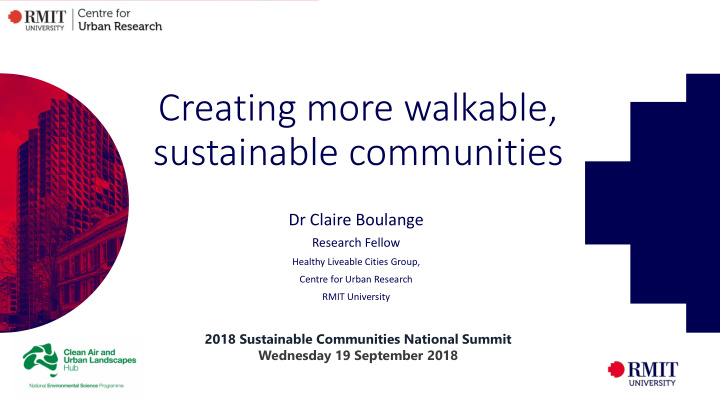



Creating more walkable, sustainable communities Dr Claire Boulange Research Fellow Healthy Liveable Cities Group, Centre for Urban Research RMIT University 2018 Sustainable Communities National Summit Wednesday 19 September 2018
“First we shape the cities – then they shape us” Jan Gehl -Cities for People
Background
What is health? Health = “a state of complete physical, mental and social wellbeing and not merely the absence of disease or infirmity” (WHO) Health is a basic and universal human right
Tips to stay healthy
Social determinants of health • Health is not just an issue of freely chosen individual lifestyle choices • Health is shaped by numerous physical, social, economic and political factors outside of the health sector • Social determinants of health = “the circumstances in which people are born, grow up, live, work and age”
Ecological model of health
Built environment as a health determinant • The way cities are planned, built and managed has a powerful impact on health risk factors and outcomes. • The built environment affects people’s behaviour and lifestyles, • and the social, educational and economic opportunities available.
How to stay healthy?
How much physical activity? Adults are encouraged to: • accumulate 150 to 300 minutes of moderate intensity physical activity ; • or 75 to 150 minutes of vigorous intensity physical activity ; • or an equivalent combination of both moderate and vigorous activities , each week ; • be active on most, preferably all, days every week; • do muscle strengthening activities on at least two days each week; • minimise the amount of time spent in prolonged sitting; and • break up long periods of sitting as often as possible .
Active travel
How is it healthy? When individuals undertake sufficient physical activity it improves: • Muscular and cardiorespiratory fitness; • Bone and functional health; • Energy balance and weight control; and • Lower risk of hypertension, coronary heart disease, stroke, diabetes, breast and colon cancer and depression
Co-benefits
However… • Physical inactivity is the fifth leading contributor to the disease burden • Almost 60 per cent of Australians aged 15 years or older being insufficiently active to benefit health • In Australia, only 4% of the workforce commutes by walking and only 1% by cycling. • The number of children walking or cycling to school has halved over the past 40 years. • Less than a third of Australian children now regularly walk or cycle to school
“Globally, physical inactivity causes 3 million deaths per year. One of the most effective means of increasing physical activity is through urban planning and transport policies ” (World Health Organization, 2009) World Health Organization (2009), Interventions of diet and physical activity: What works . Summary report. Geneva.
Planning and designing environments for active living
Walkability • A measure of how well the built environment supports walking • Typically, built environment attributes are studied in combination by means of composite measures or indices • The most common is the “walkability index” • It combines three variables: 1. Land Use Mix (something to walk too) 2. Road Connectivity (a way to get there); 3. Housing Density (more housing supply in walkable areas)
Walkability Index by Giles-Corti et al. 2013
Features of an active city • Transportation network that supports physical activity; • Easy access to shops, services and transit; • Easy access to sport and recreational facilities; • Easy access to public open spaces; • Safe and aesthetically pleasing environments.
Transport networks that support physical activity • Pedestrian and cycling infrastructure • Footpaths, pedestrian crossings, signage • Separated bike lanes and paths • Bike parking and facilities • Traffic calming • Access to transit • People can walk or cycle to and from stations and stops • Walkable community design
Melbourne's ambition to make Melbourne an active city Victorian Department of Environment, Land, Water and Planning
Planning Support Systems
What? • Computer-based simulation tools • Turn data into meaningful and useful information • Support evidence-based planning
Why do we need simulation tools? Understand the context Smooth Test transition to intervention operation scenarios Refine Reduce risks scenarios
What can you do with a PSS? • Model development feasibility on a site-by-site basis • Create and evaluate multiple land use scenarios • Test and refine transportation plans • Produce small-area concept plans • Model complex regional issues
Some case studies…
How do the tools work?
Western Australia 2017 – in partnership with LandCorp
2018 PIA Congress – Young Planner Workshop
2018 PIA Congress – Young Planner Workshop
Research piece under review - in partnership with VPA The health and economic benefits of building walkable neighbourhoods: A modelled comparison between brown Belén Zapata-Diomedi, Claire Boulangé, Billie Giles-Corti, Kath Phelan, Simon Washington, J Lennert Veerman, Lucy Dubrelle Gunn
Thank you! Further information: claire.boulange@rmit.edu.au http://cur.org.au/research-programs/healthy- liveable-cities-group/
Recommend
More recommend